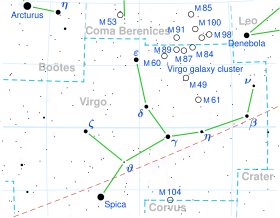Epsilon Virginis
| Observation data J2000.0
| |
|---|---|
| Constellation | Virgo |
| Right ascension | 13h 02m 10.59785s[1] |
| Declination | +10° 57′ 32.9415″[1] |
| Apparent magnitude (V) | +2.826[2] |
| Characteristics | |
| Spectral type | G8 III[3] |
| U−B color index | +0.718[2] |
| B−V color index | +0.940[2] |
| Absolute magnitude (MV) | 0.37 ± 0.06[5] |
| Details | |
Myr | |
| Database references | |
| SIMBAD | data |
Epsilon Virginis (ε Virginis, abbreviated Epsilon Vir, ε Vir), formally named Vindemiatrix
Stellar properties
Vindemiatrix is a
This star is a likely member of the thin disk population and the orbit departs by no more than 60 pc (200 ly) from the galactic plane.[14]
Nomenclature
ε Virginis (Latinised to Epsilon Virginis) is the star's Bayer designation.
It bore the traditional names Vindemiatrix and Vindemiator, which come from Greek through the Latin vindēmiātrix, vindēmiātor meaning 'the grape-harvestress'. Additional medieval names are Almuredin /ælˈmjʊərədɪn/,[15] Alaraph, Provindemiator, Protrigetrix and Protrygetor.[16] In 2016, the International Astronomical Union organized a Working Group on Star Names (WGSN)[17] to catalog and standardize proper names for stars. The WGSN's first bulletin of July 2016[18] included a table of the first two batches of names approved by the WGSN; which included Vindemiatrix for this star.
This star, along with Beta Virginis (Zavijava), Gamma Virginis (Porrima), Eta Virginis (Zaniah) and Delta Virginis (Minelauva), were Al ʽAwwāʼ, which is Arabic for 'the Barker'.[19]
In
References
- ^ S2CID 18759600.
- ^ Bibcode:1966PDAUC...1....1G
- ^
- Bibcode:1999VeARI..35....1W
- ^ S2CID 9341088
- ^ doi:10.1086/301114
- ^ Bibcode:1999A&A...352..495M
- Bibcode:2000A&A...361..614P
- ^ "eps Vir". SIMBAD. Centre de données astronomiques de Strasbourg. Retrieved May 10, 2010.
- ^ "Vindemiatrix". Oxford English Dictionary (Online ed.). Oxford University Press. (Subscription or participating institution membership required.)
- ^ "IAU Catalog of Star Names". Retrieved 28 July 2016.
- Bibcode:1993AAS...183.1710G, archived from the originalon 2019-06-25, retrieved 2012-02-04
- S2CID 16602121
- ISBN 978-1-931559-44-7.
- ^ a b Richard Hinckley Allen: Star Names — Their Lore and Meaning: Virgo
- ^ "IAU Working Group on Star Names (WGSN)". Retrieved 22 May 2016.
- ^ "Bulletin of the IAU Working Group on Star Names, No. 1" (PDF). Retrieved 28 July 2016.
- ISBN 0-486-21079-0, retrieved 2010-12-12
- ISBN 978-986-7332-25-7.
- ^ (in Chinese) 香港太空館 - 研究資源 - 亮星中英對照表 Archived August 19, 2010, at the Wayback Machine, Hong Kong Space Museum. Accessed on line November 23, 2010.
- ^ (in Chinese) English-Chinese Glossary of Chinese Star Regions, Asterisms and Star Name Archived August 10, 2010, at the Wayback Machine, Hong Kong Space Museum. Accessed on line November 23, 2010.
External links
- Kaler, james B., "Vindemiatrix", Stars, retrieved 2011-01-12

